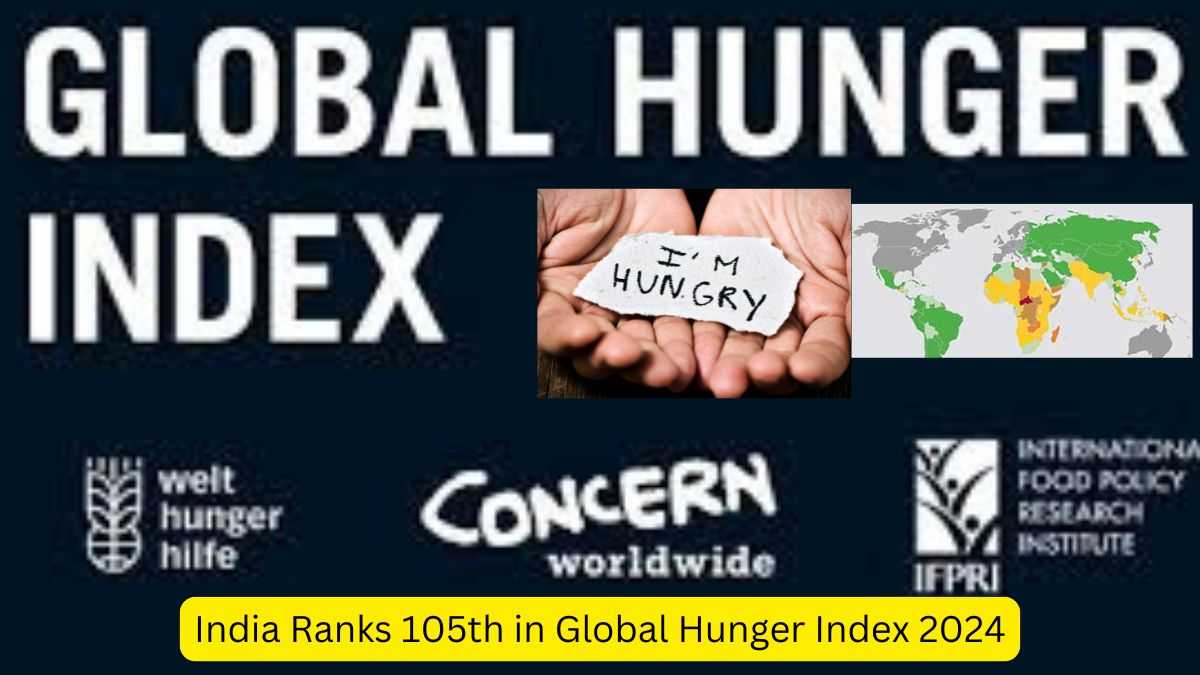The Global Hunger Index (GHI) is a comprehensive tool that tracks and measures hunger at the global, regional, and national levels. The 2024 GHI report sheds light on hunger levels across 127 countries, with specific emphasis on India’s ranking and challenges.
India’s Performance in GHI 2024
- India ranks 105th out of 127 countries in the Global Hunger Index 2024, placing it in the “serious” hunger category.
- India’s GHI score is 27.3, indicating a severe level of hunger.
Key Indicators Contributing to India’s GHI Score
Undernourishment
- 13.7% of India’s population is undernourished, meaning they do not have access to sufficient caloric intake.
Child Stunting
- 35.5% of children under five are stunted, reflecting chronic undernutrition.
Child Wasting
- 18.7% of children under five suffer from wasting, a sign of acute undernutrition where children have low weight for their height.
Child Mortality
- 2.9% of children die before reaching their fifth birthday due to a combination of inadequate nutrition and unhealthy living environments.
Global Context and Comparisons
- The 2024 GHI report is the 19th edition, published by Concern Worldwide (Ireland) and Welthungerhilfe (Germany).
- India’s ranking is worse than several neighboring South Asian countries, further highlighting the challenges faced in addressing hunger.
- 733 million people globally face hunger each day, while 2.8 billion people cannot afford a healthy diet.
Impact of Conflict on Hunger 2024
- Conflicts in regions such as Gaza, Sudan, the Democratic Republic of the Congo, Haiti, Mali, and Syria are contributing significantly to food crises.
- Several African nations are categorized as “alarming” due to extreme food insecurity driven by ongoing civil strife and war.
Challenges and Projections
- The report underscores that achieving the United Nations Sustainable Development Goal (SDG) of Zero Hunger by 2030 is increasingly unlikely without substantial progress.
- The disparity between the global right to food standards and the harsh reality faced by millions remains significant.
What is the Global Hunger Index ?
About
- The Global Hunger Index (GHI) is a peer-reviewed report, published on an annual basis by Concern Worldwide and Welthungerhilfe.
- The GHI is a tool designed to comprehensively measure and track hunger at global, regional, and national levels, reflecting multiple dimensions of hunger over time.
- The GHI score is calculated on a 100-point scale reflecting the severity of hunger – 0 is the best score (implies no hunger) and 100 is the worst.
Calculation
- Each country’s GHI score is calculated based on a formula that combines four indicators that together capture the multidimensional nature of hunger,
- Undernourishment: The share of the population whose caloric intake is insufficient;
- Child Stunting: The share of children under the age of five who have low height for their age, reflecting chronic undernutrition;
- Child Wasting: The share of children under the age of five who have low weight for their height, reflecting acute undernutrition; and
- Child Mortality: The share of children who die before their fifth birthday, reflecting in part the fatal mix of inadequate nutrition and unhealthy environments.
Top 10 Performers in 2024
| Country | Ranking |
|---|---|
| Belarus | 1 |
| Bosnia and Herzegovina | 2 |
| Chile | 3 |
| China | 4 |
| Costa Rica | 5 |
| Croatia | 6 |
| Estonia | 7 |
| Georgia | 8 |
| Hungary | 9 |
| Kuwait | 10 |
Worst Performers in the List
| Rank | Country |
|---|---|
| 121 | Niger |
| 122 | Haiti |
| 123 | Dem. Rep. of the Congo |
| 124 | Madagascar |
| 125 | Chad |
| 126 | Yemen |
| 127 | Somalia |
For the 2024 GHI report, data were assessed for 136 countries. Out of these, there were sufficient data to calculate 2024 GHI scores for and rank 127 countries (by way of comparison, 125 countries were ranked in the 2023 report). The 22 countries that received 2024 GHI scores below 5 do not have individual rankings; instead, they are grouped together and ranked collectively from 1 to 22 due to the minimal differences in their scores.
India’s Neighboring Countries
- 4. China
- 52. Thailand
- 56. Sri-Lanka
- 68. Nepal
- 74. Myanmar
- 77. Indonesia
- 84. Bangladesh
- 109. Pakistan
- 116. Afghanistan
Policy Recommendations:
- Enhance Accountability and Enforce the Right to Food: Strengthen adherence to international laws to ensure that food rights are upheld globally.
- Promote Gender-Sensitive Approaches in Food and Climate Policies: Make sure food and climate policies are inclusive, addressing gender disparities and promoting equality.
- Invest in Justice for Gender, Climate, and Food: Direct public funds towards reducing inequalities, focusing on gender, climate, and food justice.
Initiatives by the Government of India to Combat Hunger:
- Mid Day Meal Programme: This flagship initiative is designed to boost enrollment, attendance, and retention rates in schools. It also aims to improve the nutrition of children in government, local body, and government-aided primary and upper primary schools nationwide.
- National Food Security Act, 2013: This act ensures that 75% of the rural population and 50% of the urban population receive subsidized food grains under the Targeted Public Distribution System (TPDS), covering about two-thirds of the country’s population. It places a particular focus on nutritional support for women and children.
- Poshan Tracker: Developed by the Ministry of Women and Child Development, this ICT application is a vital tool for governance. It dynamically tracks stunting, wasting, underweight, and obesity in children by utilizing WHO’s expanded z-score tables based on height, weight, gender, and age.
- Pradhan Mantri Garib Kalyan Anna Yojana (PMGKAY): Launched to address the economic disruptions caused by the COVID-19 pandemic, PMGKAY provides free food grains in addition to the regular allocation under the National Food Security Act (NFSA), 2013.
- Saksham Anganwadi and Poshan 2.0 (Mission Poshan 2.0): This includes key schemes like POSHAN Abhiyaan, Anganwadi Services, and the Scheme for Adolescent Girls. These are focused interventions aimed at tackling malnutrition. Under the Anganwadi Services scheme, children aged 0-6 years, pregnant women, and lactating mothers receive supplementary nutrition, either through Hot Cooked Meals or Take Home Rations (not raw ingredients).
| Summary/Static | Details |
| Why in the news? | The Global Hunger Index (GHI) is a comprehensive tool that tracks and measures hunger at the global, regional, and national levels and with specific emphasis on India’s ranking and challenges. |
| India’s GHI 2024 Ranking | 105th out of 127 countries (Serious Hunger Category) |
| India’s GHI Score | 27.3 (Severe hunger level) |
| Key Indicators Contributing to GHI | – Undernourishment: 13.7% of population
– Child Stunting: 35.5% of children under five – Child Wasting: 18.7% of children under five – Child Mortality: 2.9% of children under five |
| Impact of Conflict on Hunger | – Conflicts in Gaza, Sudan, Syria, and others contribute to food crises. |
| Challenges & Projections | – Achieving Zero Hunger (SDG 2030) is increasingly unlikely without substantial progress. |
| Top Performers (2024) | 1. Belarus,
2. Bosnia and Herzegovina, 3. Chile, 4. China, 5. Costa Rica |
| Worst Performers (2024) | 121. Niger,
122. Haiti, 123. Dem. Rep. of the Congo, 126. Yemen, 127. Somalia |
| India’s Neighboring Countries | 4. China,
52. Thailand, 56. Sri Lanka, 68. Nepal, 109. Pakistan |




 NITI Aayog Report Hails Gujarat Biotechn...
NITI Aayog Report Hails Gujarat Biotechn...
 Ahead of Nadella and Pichai: Jayshree Ul...
Ahead of Nadella and Pichai: Jayshree Ul...
 Wildfires and Natural Disasters Cost the...
Wildfires and Natural Disasters Cost the...







